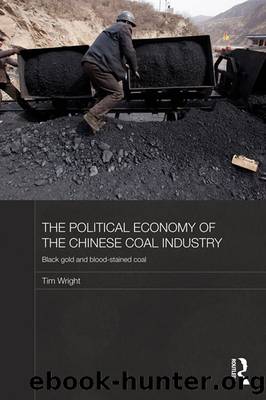The Political Economy of the Chinese Coal Industry by Wright Tim

Author:Wright, Tim
Language: eng
Format: epub
Publisher: Taylor & Francis
Figure 5.1 Chinese coal output, 1992–2003
Note: The shaded area showing the difference between the two sets of output figures is an estimate of the amount of output originally under-reported.
Sources: ZTN 2005: 14-19, 2010: 14-23.
It would, perhaps, be wrong to conclude that the policy completely failed. Output did stop growing, even if it did not decline to meet the official targets. By reducing supply, the policy may have contributed to rising coal prices and to the renewed profitability of the SOE coal sector. One mine manager in Jiangsu argued that the policy had ‘saved the life’ of the province’s coal mines, enabling them to become profitable for the first time (Xinhua 2002d). On the other hand, changing market conditions were more important than policy in bringing about first the temporary halt in output growth and then the recovery of prices and profits (Interview 2004c).
There are similar issues with reports of mine closures. Several announcements stressed the closing of tens of thousands of small coal pits, so that the number of TVMs fell from 78,000 in 1997 to 23,000 in April 2002 (Da 2002: 12; Pan 2002a: 12). However, these figures overstate the policy’s success. First, some mines reported as closed had already ceased operations for economic reasons (Interview 2004e). Double counting was a major concern for the authorities, as counties and townships contravened the guidelines by including in their statistics ‘dead tigers’ – mines closed before 1997 (ZMB 10 April 1999: 1, 19 October 1999: 3). Second, the disappearance of a mine from the statistics often meant no more than that: it was no longer formally registered and did not report its output, but it may well have reopened as soon as the officials’ backs were turned or continued to operate illegally, often at night, concealed from officials’ eyes (CD 3 December 2004: 5). Illegal mines often came to public attention only after accidents. In 2002, 244 out of the 500 fatal mining accidents in Guizhou occurred in illegal mines (Guizhou nianjian 2003: 280).
It is impossible to quantify this phenomenon nationally, but it was certainly extremely common. Up to 2003 alone, little more than 2 per cent of the 2000 mines in Meizhou were fully licensed (Lin 2007: 41). Similarly, in 2005, there were an estimated 4000 unregistered or ‘black’ mines in Shanxi, and 1000 in Taiyuan alone, none of which was included in the official statistics for mines or for output (Zhonghua gongshang shibao 5 January 2007: 6; Zhongguo jingji shibao 11 July 2007: 2). A team investigating safety in Guizhou also reported that most of the TVMs under investigation ‘were closed for public purposes but operated in secret’ (Guowuyuan 2004b). Even in Tangshan (Hebei), a relatively developed area close to Beijing, although 94 mines were closed, 103 mines reopened. One mine was closed and reopened seven times in 1998–9 (ZMB 18 July 2000: 2; Li Rentang 2002: 14). Claims relating to closing mines therefore told, at most, only part of the truth. According to the provincial yearbook, Nayong County, a model for Guizhou, closed almost 400 mines in 1997, reducing the total number to 200.
Download
This site does not store any files on its server. We only index and link to content provided by other sites. Please contact the content providers to delete copyright contents if any and email us, we'll remove relevant links or contents immediately.
| African-American Studies | Asian American Studies |
| Disabled | Ethnic Studies |
| Hispanic American Studies | LGBT |
| Minority Studies | Native American Studies |
Cecilia; Or, Memoirs of an Heiress — Volume 1 by Fanny Burney(31333)
Cecilia; Or, Memoirs of an Heiress — Volume 3 by Fanny Burney(30934)
Cecilia; Or, Memoirs of an Heiress — Volume 2 by Fanny Burney(30889)
The Great Music City by Andrea Baker(21317)
We're Going to Need More Wine by Gabrielle Union(18074)
Bombshells: Glamour Girls of a Lifetime by Sullivan Steve(13109)
Pimp by Iceberg Slim(12932)
All the Missing Girls by Megan Miranda(12752)
Fifty Shades Freed by E L James(12451)
Norse Mythology by Gaiman Neil(11883)
Talking to Strangers by Malcolm Gladwell(11879)
Crazy Rich Asians by Kevin Kwan(8350)
Mindhunter: Inside the FBI's Elite Serial Crime Unit by John E. Douglas & Mark Olshaker(7834)
The Lost Art of Listening by Michael P. Nichols(6474)
Enlightenment Now: The Case for Reason, Science, Humanism, and Progress by Steven Pinker(6406)
Bad Blood by John Carreyrou(5769)
The Four Agreements by Don Miguel Ruiz(5511)
Weapons of Math Destruction by Cathy O'Neil(5037)
We Need to Talk by Celeste Headlee(4870)
